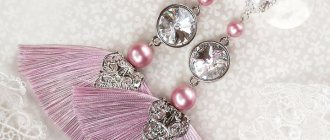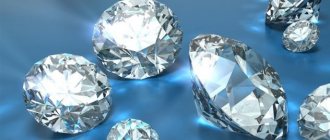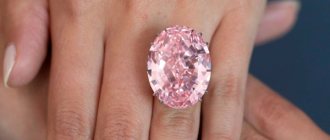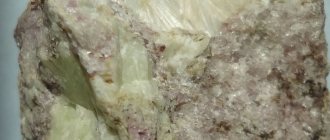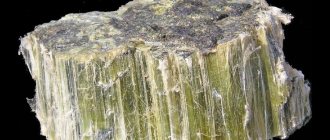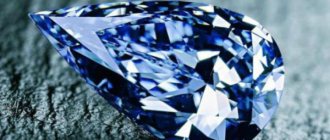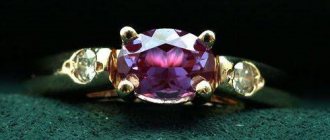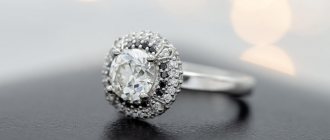It’s amazing how the same stone can awaken the most different intentions and aspirations in a person - there has been an unfair struggle for diamonds for centuries, today these precious stones are the most valuable exhibits at exhibitions, and the cost of diamonds at auctions grows to unimaginable limits. Diamonds evoke the brightest emotions, delight, but at the same time give rise to dark thoughts inspired by the desire to own the treasure alone.
| The most expensive diamond “Pink Star” (59.6 carats, Sotheby's, Hong Kong, $71.2 million) |
In the world of jewelry, everything is not so categorical; diamonds in products and accessories are represented so widely that every buyer can choose stones in any price category, literally starting from several thousand rubles.
Diamond - what is it?
This precious stone is a diamond cut in a special, ultra-precise way: the edges are arranged in such a way that the natural beauty of the stone is emphasized - its color, transparency, light refraction. Jewelers have developed enough types of cuts to find a personal approach to each diamond, a method that will help create a beautiful, shining diamond.
In the buyer’s language, a diamond is a beautiful stone, a symbol of wealth, and in former times, power: only the nobility and royalty were allowed to wear cut diamonds. Of course, a diamond is a win-win gift option. It will never be superfluous, it is unlikely that anyone will refuse such a gift or say “thank you, but I already have it.” There are never too many diamonds, let alone too many, the value of stones only grows over time, and no modern developments in creating synthetic analogues are ready to compete with diamonds.
Cullinan I
Nine largest diamonds cut from rough Cullinan (Cullinan I top middle)
Cut weight: 530.4 carats
The Cullinan I, commonly known as the Great African Star, is an almost pear-shaped diamond with 74 facets. In 1992, the Golden Jubilee Diamond surpassed the Cullinan I as the world's largest cut diamond of any color. The former, however, is still the largest clear cut diamond. Cullinan I was valued at $2.5 million (now about $51 million) in 1908.
Since 1910, Cullinan I can be seen atop the Scepter with a Cross, a decorative gold rod held by the monarch during coronation, which has been redesigned to accommodate it.
The diamond is set in such a way that it can be removed and worn independently. In 1911, Queen Mary wore four of the largest Cullin diamonds during her first State Opening of Parliament.
Diamond Categories
The cost of a cut stone directly depends on four parameters - the color of the diamond, its clarity, quality of cut and carat (weight, 1 carat = 0.2 grams). The higher all these indicators are, the more expensive the diamond is valued. Unique characteristics are not found very often, and such clean, perfectly cut stones, each in its own category of color and weight, are auction items and are found in private collections. The cost of diamonds in this category amounts to hundreds of thousands and tens of millions of dollars.
Jewelers use the 4C rule to evaluate stones: Carat/Color/Clarity/Cut – weight, color, transparency (purity), cut. Each category has its own characteristics, and they are not always clear to everyone who is far from the jewelry profession. But even the basics that allow you to understand the value of diamonds will be enough to choose and buy any other jewelry with a diamond that has a truly decent value.
Diamond carat
In the ancient times of the Ancient East, when the equipment available to modern masters of precious stones and metals could not even be dreamed of, the weight of diamonds, like other stones and even food products, was compared to the seeds of the carob (Caribbean) tree. Ceratonia capita in Latin has a name consonant with the word “carat” - cerátiοn. The stable mass of these seeds, equal to 0.2 grams, became a measure of weight, among other things, for diamonds.
One such grain is the equivalent weight of a diamond of 1 carat (Ct). But a diamond, even a faceted one, has a special property: stable, unchanging density. This quality became the basis for grading the carat of diamonds according to their diameter (or width in millimeters). You can measure these values and correlate them with the carat table, the values will be identical, and the differences will be tiny and meaningless.
For diamonds weighing more than 1 carat, this rule applies in the same way; the ratio of the diameter of the stone and its weight can always be compared with the data in the table and the results of weighing on special equipment - there will either be no discrepancies at all, or their presence will be reduced to a slight minimum.
The joke that a real woman can determine the carat value of a diamond by eye without a scale is not a joke at all. The photo clearly demonstrates the relationship between size and carat weight, assuming the diamond is on the finger.
Of course, remembering all the sizes is not so easy. But for fans of diamond jewelry, there is a proven life hack:
- if you take as a basis the smallest diamond, half a carat, and the largest, 7 Ct, and also remember how a 3-carat stone looks on your hand, all other intermediate values can be determined by focusing on the larger and smaller sides of the average size.
It is worth remembering that this data can only be applied to diamonds, the data is derived relative to their density. This system is not suitable for sapphires, rubies, topazes and other precious stones. Visually, a 1 Ct diamond and, for example, a ruby will be different sizes; corundum is noticeably larger than a diamond with equal carat stones.
Diamond color
To distinguish diamonds by color, a universal international designation system has been developed using the GIA (Gemological Institute of America, an independent organization) method, where the gradation is designated by the letters D to M.
Colorless diamonds are the most expensive on the jewelry market; these are stones of categories D, E and F. Understanding the difference between stones of this highest category is the work of a specialist with extensive experience. Such diamonds belong to the investment group and are used in exclusive jewelry or for storing and increasing funds. The cost of such stones increases by 10% annually.
GH is the second category, such diamonds are also quite valuable, but have a lower price due to a barely noticeable yellow tint.
All other diamonds, from I to Z, belong to the group of inexpensive colorless stones and are most widely used in jewelry.
In addition to the international GIA system, there is a Russian gradation: it is more complex and is designed primarily for professionals - jewelers, appraisers.
The color relationship between GIA and Russian parameters depends on the carat of the diamond and for this reason there are some discrepancies between the data of the international and Russian classifications.
Among other things, the Russian scale has developed a color rating system for diamonds with different cuts - 17 facets, 57, and so on. This part of the gradation is needed only by jewelers to certify stones.
Light transparent stones are not the only existing standard; cut diamonds can have different shades and sometimes the usual colorless diamonds are not so interesting and are not valued highly enough against the background of blue, green, pink, and gold shades. Therefore, for all diamonds that have a different color, the Fancy group has been developed - fantasy shades. The darker the color, the higher the cost of such a diamond.
Diamond Clarity
Assessing color without the clarity of a stone is almost pointless; these parameters are interdependent, although it is very difficult to find a stone with an ideal relationship between color and clarity - these are expensive, rare, beautifully cut diamonds. Moreover, only a professional can give an objective assessment of this parameter. Clarity
or transparency - a parameter showing how many defects a stone has and how much these inclusions affect the appearance of the diamond.
Nature has not yet created a single diamond without a single inclusion, and if you see a stone with perfect transparency, in which even the smallest, insignificant defects are completely absent, it is a fake.
As in the case of color, jewelers use the international GIA system and the Russian scale. The GIA scale includes 11 classes, in which defects can have varying degrees of visibility, be located inside the diamond, on its outer surface and, depending on the intensity and location, affect the clarity of the stone. The Russian scale, as in the case of color, is more complex and classifies the clarity of a stone not only by the presence of inclusions, but also in their relation to the weight of the diamond and the number of facets.
The buyer can rely on a simplified purity assessment system presented in the table (the ratio of the letter GIA to the Russian number scale)
It is worth remembering that diamonds of category IF ( INTERNALLY FLAWLESS
) are the rarest, unique stones, the defects of which are reduced to damage to the outer surface that is barely visible even under magnification, provided that they can be reduced by polishing. Such diamonds are the main participants in prestigious exhibitions, the most expensive lots at prestigious auctions at the level of Sotheby's or Christie's.
We are sure you noticed a beautiful blue diamond at the beginning of the article - this is a Winston Blue, a stone of the highest, impeccable purity, weighing 13.22 carats, which was sold during one of Christie's auctions for $24.2 million. A cushion-shaped diamond of the same color, but grade VS2, cost more than $1.8 million per carat in 2013.
Large stones VS1-VS2 are considered very good, worthy under other conditions of auctions, and VVS1-VVS2 are considered expensive, collectible. For the manufacture of jewelry for mass sale, with small diamonds, up to 0.3 carats and a little higher, stones of categories SI 1-SI 2 are used, and for quality products even categories I1-I3 (6-12 positions on the Russian scale) are not used. If you want to buy a good diamond, its transparency should not be lower than SI3 on the GIA scale, that is, 7/7a according to the Russian gradation.
Data about diamonds is indicated on the product tag or in the certificate, and now you can easily decipher the meanings.
Diamond cut
This parameter alone may require a separate, impressively voluminous article, so we will only touch on the most popular types of cuts. In total, cutting methods number in the dozens, and the numbers tend to hundreds of options. But not all are used in modern jewelry - there is no need and, probably, suitable stones. Like all previous parameters, the cut that turns a diamond into a beautiful diamond is judged by its quality. And the main requirement for processing is the creation of geometrically accurate, preferably flawless, edges and their proportions. The number of sides also differs, depending on the style:
- 17 facets - simple type of cut
- 33 – Swiss style
- 57 – classic full Tolkowsky cut
- 73 – “highlight-cut” type (increases radiance)
- 86 – royal cut
- 102 – majestic, only for large diamonds
These forms are used constantly today, and the choice of cut type always depends on the initial quality of the diamond and its characteristics. With the help of the right cut, you can give your future diamond maximum brilliance, and the precise placement of the edges will help hide defects or at least make them less noticeable.
All types and shapes can be divided into three categories - brilliant cut, step cut and mixed cut. Each has its own advantages: for example, stepped
The emerald and asscher cuts are perfect for clean stones and only highlight the natural characteristics of diamonds.
Diamond
cut - one that is based on the principle of best light refraction, can have 57 facets and more. Such stones demonstrate an incredibly bright, multi-faceted shine, and are used in most cases for round diamonds and all where a rectangular or square shape is not required. It is because of the ability to bring out the best characteristics of a diamond and transform it into a beautiful diamond that this form is used more often.
Mixed
cutting is an opportunity to preserve the weight of a diamond, its quality, color; it is successfully used if the stone has a number of flaws that are required and possible to hide, and at the same time emphasize the shine and light reflective qualities of the stone. This method was invented in the middle of the last century in Sri Lanka, and to this day the method is successfully used in princess, radiant, and pear (aka drop) cuts.
Choosing a cut is not an easy matter, and jewelers make a lot of calculations before starting to process a diamond, and the final decision may come months after the first acquaintance with the diamond. Still would! The cut literally decides the fate of the stone: a wrong decision will ruin the stone, turning even a very clean diamond into an unusable diamond with even one imprecise cut.
What determines the price of a 1 carat diamond?
The evaluation takes into account transparency, color purity, and cutting accuracy. Deviation of at least one parameter from the standard reduces the value of the nugget. The price is also affected by the size of the diamond. After processing, it can have 1.0–1.999 ct or another carat value.
You can buy uncut chips of various shapes up to 300 microns (0.3 mm) in size for 35 euro cents/1 piece. A small nugget weighing 0.29 ct costs up to 50 thousand rubles. The price of medium cut minerals (0.3–0.99 ct) is in the range of 27,000–350,000 rubles.
Large diamonds weighing ≥ 1.0 ct are sold for at least 280 thousand rubles.
Why are diamonds so expensive?
In general, your understanding of how the cost of diamonds is formed has already been formed - we just need to remind you of the main parameters. The price of these magical stones, enchanting with their shimmer, is partly the result of the skill of the jeweler, but the rest is literally a matter of luck: finding a pure diamond, putting skillful hands on it, showing it in the best light.
Large diamonds/high clarity/the right color/ideal cut – the chance is literally exceptional, such stones are incredibly rare and have an unrealistically high cost.
Stones that are more widespread are also not so cheap, but the reasons are the same: characteristics, or rather their combination. In addition, it is not easy to mine diamonds; deposits of high-quality stones are located at a depth of more than 300 meters, and most of them become suitable only for technical needs. There are not many diamonds worthy of cutting even for the general market.
Let's add to everything the exceptional strength of diamonds - this is the most durable, and therefore literally eternal stone, the highest rating on the Mohs hardness scale. And against the backdrop of such advantages, the advertising campaign for high-quality, expensive diamonds carried out on behalf of De Beers at the beginning of the last century does not seem to have had much of an impact on interest in the stones. How else can we explain the passion of monarchs, kings, and rulers of ancient times for diamonds?
How to buy a diamond without being scammed
In fact, in the modern world, the diamond sales market has grown into a civilized, well-structured process. All precious stones are accompanied by an official document, which also has legal significance. Diamonds in general sale, presented in jewelry stores, depending on their category, have either a store tag or an appraisal certificate from one of the specialized companies. In Russia, reputation is valued no less than in GIA and is highly respected, including among foreign partners, by more than one company.
Of course, GIA specialists have earned the greatest trust; this institute is not commercial and does not focus on the influx or lack of clients, unlike commercial organizations - such companies often inflate the characteristics of a diamond in order to please the customer.
We have written another detailed review on how to distinguish a real diamond from a fake.
The most popular and expensive diamonds in the world
The mystery of these incredibly expensive diamonds will never be solved - what motivates everyone who buys a stone for twice or more than the starting price of the auction? Probably, diamonds really have the ability to control the will of a person. We don’t argue, for example, Oppenheimer Blue
– it is magnificent, although not as large as other high-grade diamonds, only 14.62 carats.
The initial cost of this luxurious blue diamond was only $30 million, and was a third lower than the estimate - just over $40 million. This did not prevent the diamond from finding a new owner for $57.5 million.
We agree: the diamond has an ideal combination of color with the best cut shape for it, and excellent companions were used.
Not every diamond is worth fabulous millions, but many of the stones have historical value. Like the next example, the famous Archduke Joseph.
The stone is named after its owner, Joseph Augustus of Austria, great-grandson of Louis Philippe, the French king. A diamond would be a standard of purity if it were exhibited in museums. Color of the highest category D, flawless cut, giving the diamond an unusually soft shine. The family jewel of the Archduke's family weighs 76.02 carats, and was put up for auction at Christie's in 2013 for $15 million at an initial cost.
The final blow of the hammer fixed the price at $21.48 million, and the diamond passed into the possession of an anonymous buyer.
There are many more examples that can be given - the Pink Star diamond, sold for $71.2 million, the Orange (gold diamond, worth $36 million), the pink Prince diamond ($39.3 million), the Marie de Medici diamond and other “stars” of the jewelry podium. They are all beautiful and inaccessible, as everything exceptional should be.
Checking the weight for size
At home, you can check the carat value with a caliper and then compare the numbers using the size table. When comparing weight, you need to look at the type of cut. The diameter of a 1.0 ct round brilliant diamond is equivalent to 6.4 mm. A 2 mm nugget is equal to 0.013 ct. A size of 3 mm corresponds to a value of 0.043 ct, and a size of 4 mm corresponds to 0.08 ct.
If the cut is made out of proportion, the weight does not correspond to the standard in the table. This lowers the value of the nugget, although sellers may not lower the price.
Beautiful and affordable diamonds – photos
Most likely, you have noticed that diamonds that are not colorless have the highest artistic value. But in real, non-auction life, everything is quite the opposite and it is white stones that have no color, or at least with an indistinct tint, that are used in jewelry. And they are also beautiful and charming.
A good selection of jewelry with good quality diamonds is in our catalog. We are pleased to give all customers an additional 5% discount when purchasing any jewelry online, and also invite you to join auctions to reduce prices.
